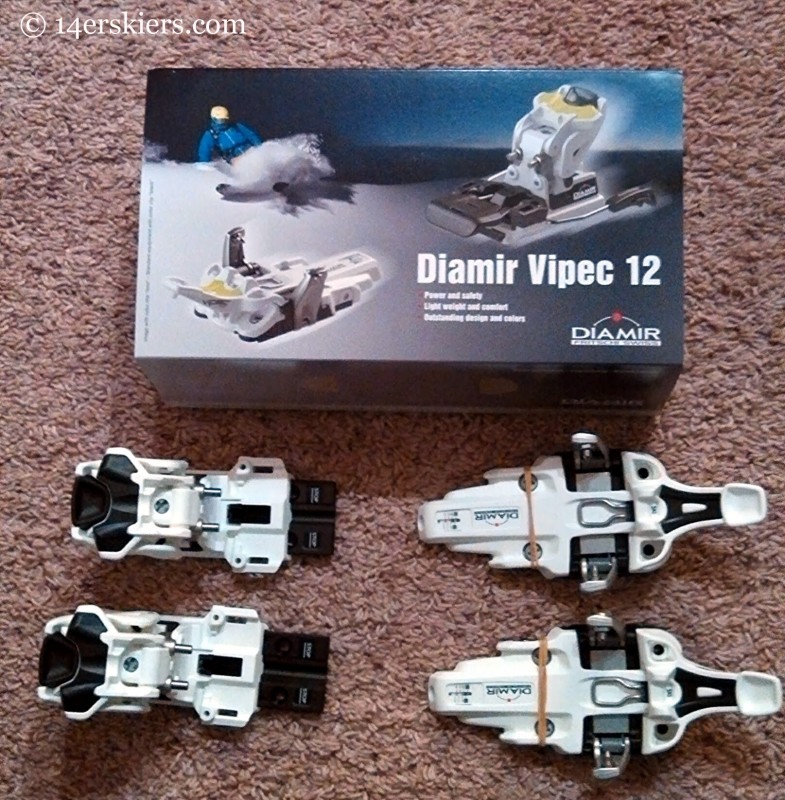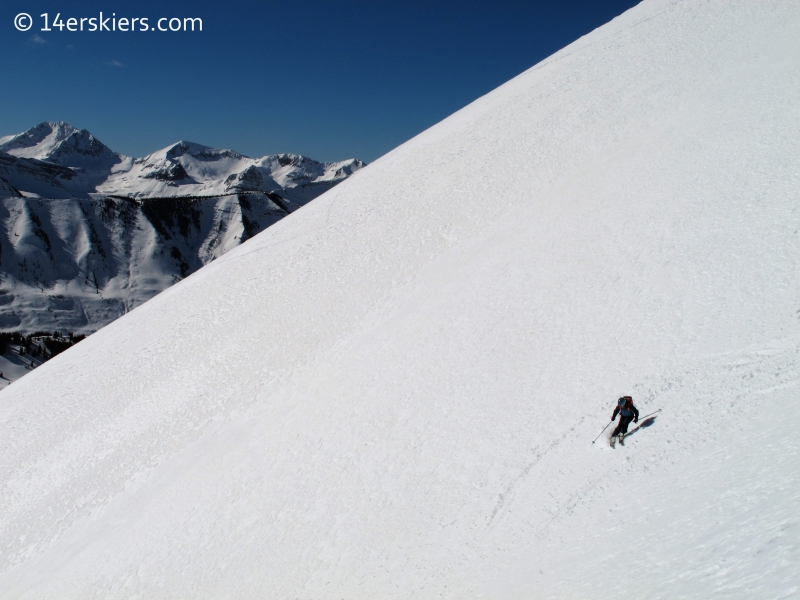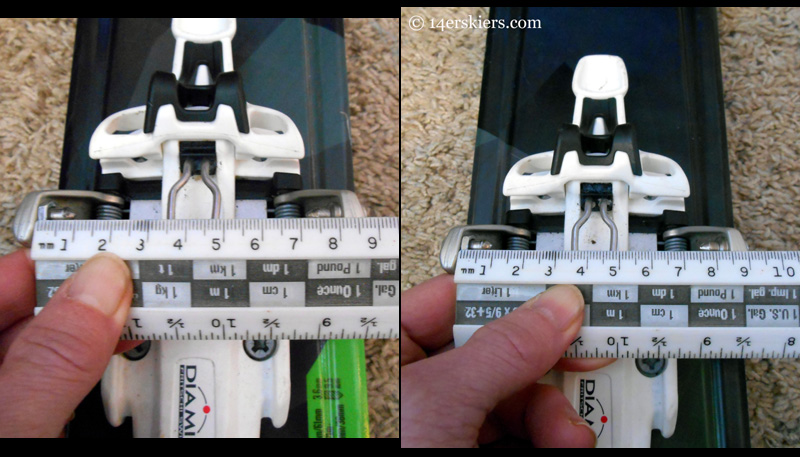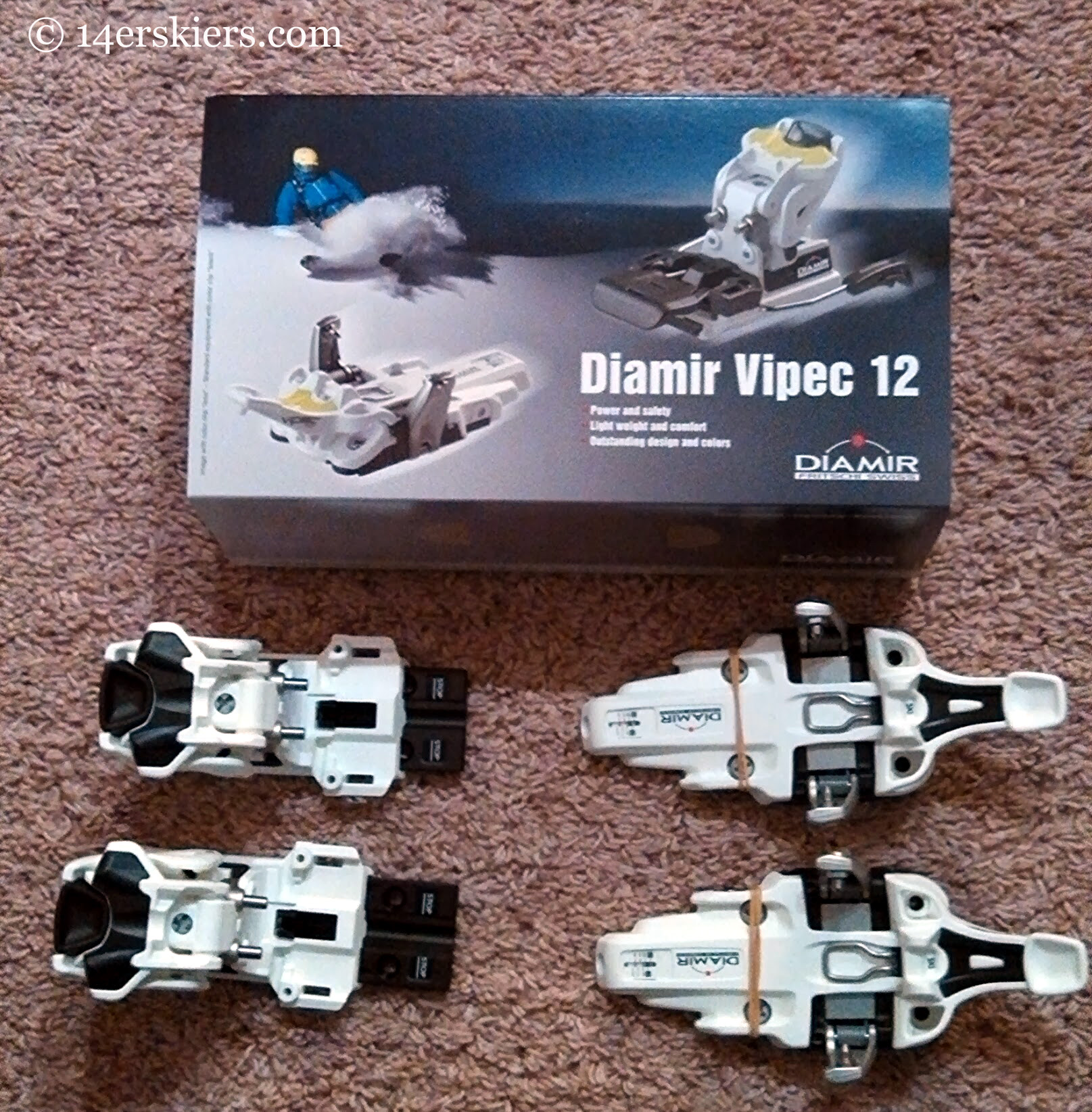Gear Review: Fritschi Vipec Tech Binding
(Last Updated On: )

The Fristchi Vipec’s are the binding I’ve been waiting to hit the ski market for years. Finally, someone figured it out – a tech binding that has elasticity and lateral release. Thanks to Fritschi for giving it a go.
I haven’t hopped on the Dynafit bandwagon. I’ve watched too many skis mounted with Dynafit bindings go rocketing down mountains. I prevented one from flying over a cliff by sticking my pole out and flipping the ski. Also, with my dual-ACL reconstructed knees that are rickety enough to belong to the Tin Man (where’s my oil?!). A rigid Dynafit tech binding was going to wreak havoc on my knees. So, I stuck to the old reliable – my Fritchi Pros.
But Fritschi now has the Vipec and I’m pretty sure the Vipec is here to stay for awhile. While the binding, as is true with almost any new AT binding, has had a few issues, they are being resolved. And I think the Vipec has made a nice showing on the stage.

Easy Switch
Fritshi took the people’s pet peeves of other tech bindings and fixed them. For example, traditional tech bindings won’t allow skiers to switch easily from ski mode back to tour mode. In order to switch from from skiing to touring, the ski usually must be taken off. This is not the case with the Vipec. Skiers can leave skis on during the switch from skiing to touring and back, making the binding easier to use on undulating terrain on the way out of a long tour.
Weight
The Vipec comes in at a highly competitive weight. I have seen reports of a single Vipec binding weighing 470 grams without brakes, and 599 with brakes. Black Diamond is reporting the Vipec as 1090 grams per pair with brakes. As a comparison, Dynafit is reporting its TLT Radical Z12 as 599 grams (single, with brake).
Release Value
Tech bindings don’t work on DIN, they work on release value. Most tech bindings only have release available in the heal, not in the toe. The Vipec has a release in both the heal and toe and has adjustments for this release on both ends. The release value spans from 5 to 12. Furthermore, the release in the toe is lateral, similar to an alpine binding. However, the heal release works like most other tech bindings do- based on frontal (fore/aft) movement. After stepping in for tour mode, skiers have the option to change the toe lever to “walk” mode. It is my understanding that this more or less “ups” the release value a bit, without fully locking. The premise behind this is that the toe undergoes a lot more torsion in tour mode and therefore should have a higher release value. However, this “walk” mode does not fully lock out the toe. It should still release in cases of a bad fall or avalanche.
Elasticity
The elasticity in the Vipec is noticeable. While certainly being more rigid than any alpine binding I have skied, the Vipec is certainly more forgiving than traditional tech bindings. This is great when the conditions get a little bid chundery or chattery. I’ll attest to the fact that it’s a lot nicer on my knees. This elasticity comes from the ability of both the heal and toe carriages to slide similar to alpine bindings. The toe carriage can slide laterally up to 13 cm. The heal has a dynamic range of 4 mm. But, most importantly, the heal piece glides on the mount to allow for consistent contact pressure when the ski is flexed. This allows the binding to stay engaged when the ski is flexed, whereas traditional tech bindings would sometimes release due to lack of elasticity (causing many people to ski them in “lock” mode).
Heel
When stepping in to ski, the heal has that solid locking sound is synonymous with Fritschi itself. I always knew when my Fritschi Pros were good to go and the Vipecs are no different. Furthermore, there are three levels to the heal riser, and each level is easy to use once you get the knack for operating it.
The video below demonstrates the ease of transitions from ski mode to tour mode, and utilizing the risers:
Fritschi Vipec Binding Heal Transitions from 14erskiers on Vimeo.
Toe
The toe comes with adjustable toe pins (more on this below) which allows for variations in tech fittings in various boots. While most boots have a standard width, a variation of 1 or 2 mm can make a huge difference with these tiny tech pins. So, the adjustment is there for those few boots that may not have the exact fit needed for other tech bindings. In addition the toe has a wire step-in trigger which reduces the complications of snow building up on the toe of the boot which can prohibit the pins from locking on to the boot correctly. I can attest to the fact that snow build-up has never been a big problem in getting these bindings on my boots.
Toe Redesigned for 2015
After taking in reports of actual skiers using the Vipec in the backcountry, Fritschi redesigned the toe of the to improve both reliability and performance. The following changes were made:
1)In my original report, I mentioned that the springs that hold the wings apart seem to change tension after time and this tension is not adjustable. In the original version, this made it so I could not just step my toes into the binding as the toe piece on the boot would hit the pins on the binding because the wings would not open far enough. I had to push down on the toe lever in order to get the wings open enough to put the toe in. The new model of the Fritschi has been reported to have fixed this issue by making the wings expand outward further.
2) The Vipec has also been known to be difficult to step into in the first place. After using them for quite some time, I became used to this and developed my own efficient methods for getting into the Vipecs. But, this year’s model has an improved toe guide which makes stepping into the Vipec absolute cake.
3) Upon release of the original Vipec, there were reports that some of the adjustable pins were falling out. I never had a problem with this because I prevented the issue by adding Loctite to the adjustable pin. Originally, the adjustable pin was on the left side of the binding. If you think about how a person skins, this would mean that every time the person picked his/her heel up, the pin would loosen. By switching the adjustable pin to the right side instead of the left, the problem of the adjustable pin loosening was resolved. There is also a retention clip that helps address the issue of the adjustable pin loosening.
Cons
Many of the original problems occurred in the toepiece of the Vipec. The toe has been redesigned, and those problems have been addressed.
However, one problem still exists in the heel. Update 6/2014– After using my Vipecs in spring conditions, specifically spring powder, I had some difficulties stepping down into the heel. While the boot would step down, it didn’t seem like the heel was actually locking. On the third time this happened, we investigated the problem and found that there was snow build up inside of the binding that prevented the heel lever from actually locking fully. This only happened three times, after using them about 70 days. Each time it happened, it was in wet spring powder. The details of this issue are covered more fully in a review of the Vipec by Earn Your Turns.
Update 2/15 – This year, with unseasonably warm conditions, I have experienced this issue in the heel a few more times. While I have come up with a few ways to fix the issue in the field, I would like to not have the issue in the first place.
Conclusion
The Fritschi Vipec has redesigned tech bindings to address a lot of the problems that people were having with traditional tech bindings. With it’s Easy Switch system, elasticity, and lateral release, the Vipec has revolutionized tech bindings for good. Improvements to the toe pieces have improved both reliability and performance. The next thing I would like to see are improvements to the heel so that the lever is not prevented from locking back in to ski mode.
Still, after skiing the Vipec for over a year, I consider the Vipec to be a reliable binding. It skis well and tours well. And I like the reassurance that the binding will is more likely than traditional tech bindings to release in a hard fall. The Vipec is overall lightweight, yet hardy. In have put it through some serious abuse this spring and it has withstood it all!
The following information only applies to the 2013-14 version of this binding. This post has been updated to reflect the changes to the Vipec in 2015. However, the information below is for historical purposes
Every first generation binding has some issues to work out, and every binding has a couple of issues. Here’s the cons that I have found in the Vipec:
1) Toe pins fall out – (update 6/2014 – this issue has been fully resolved unless you have one of the first Vipecs & purchased them in mid-January or before) This was an issue that people found only a few weeks after the Vipec was released to the public. Basically, the one pin on the toe that could be adjusted was sometimes coming loose and/or falling out when people were touring. This is only true with the original version of the Vipec. It is my understanding that all the pins are now coming with loctite on them to prevent this from happening. However, that means if you have one of those few boots that doesn’t fit the tech fitting exactly, then you will have to somehow undo the red loctite (which can be hard to do) to adjust the pin to the desired length.
2) Wings in step-in mode don’t seem to be a consistent width. I have two pictures below showing two different widths of the wings in step-in mode. I actually ended up returning both of these toe pieces. Since then, BD sent me a new pair of toe pieces. One of the toe pieces had wings that were so narrow in step-in mode, that I couldn’t actually step in without hitting the pin.

3) It is hard to actually step-in to the toe. Now, it seems that every tech binding is a little finicky when stepping in to the toe. But, this one seems particularly hard. The Black Diamond reps have told me to step in to the heal first, then into the toe. Sometimes this works well. Sometimes it does not. It seems that the wings are often just a little too narrow to really make this work. I often hold the toe lever down to help widen the wings to step in, and then release it upon engaging the wire step-in trigger. I did find that when I used a newer pair of boots to step into this binding, the move was easier. Still tricky, but much better. It seems as though older, more beat up boots make the toe step-in process more difficult.
Update 6/2014– After using my Vipecs for more time, I have developed better strategies to step into the toe on the Vipecs. My favorite technique, which I figured out on my own (prior to the video below), involves holding down the toe lever until the pins are in. Earn Your Turns demonstrates this technique around 45 seconds into the video linked below:
Additionally, I found that a newer Shiva with a different cut in the toe (compared to an older Shiva) helped.
- Mount Buckskin (17 May 2020) - May 28, 2020
- Horseshoe Ski (14 May 2020) – The mountain whose journey nearly killed me - May 27, 2020
- Sayres X-Rated Ski (10 May 2020) - May 19, 2020







Nice and detailed review. The updates make this review even more relevant at they address issues found by using the binding. Thanks for taking the time to write and update.
Thanks! Hope you found it useful 🙂
Any update on your opinions after further use of the Vipecs? Did you upgrade to the new style toe?
No I have not upgraded to the new style toe, but I have adjusted and don’t really have a lot of trouble getting in them any more. The problem now lies in the heel, which I mentioned before. It becomes packed with snow in wet-snow conditions. So, early season I encountered this same problem. But, during winter now, I haven’t been encountering it at all. Except for this problem, I am pretty happy with this binding. It has been very reliable.
Hi there, how do you think this binding would do for someone who’s 6’5″ 200lbs and on salomon rocker 2 122’s? I’d probably use this ski about 50/50 backcountry/resort.
Hi Eric,
If you were to use that set up as you described as a backcountry set up I think it would be great. But, putting a tech binding at the resort changes things. Tech bindings are really not suited for pounding laps on hard pack at the resort. That’s just not what tech bindings are made for and putting that kind of abuse on a tech binding with a person your size would not be recommended. The only tech binding that MIGHT be okay is the Dynafit Beast. You could also check out the CAST binding system. Or just go with the Marker Duke, which I use a lot in bounds – although it is heavy and not great at touring. But, it does the job…
Referring to the snow packing into the heel and preventing ski mode from locking:
“While I have come up with a few ways to fix the issue in the field, I would like to not have the issue in the first place.”
What are the techniques to fix it?
I find that blowing some hot air into the pocket that collects the snow makes it melt enough to push the heel into locking position. About 10 big blows usually does the trick!
Pingback: Problems Diamir Vipec problemas. Soluciones Improvements – alivemountain.com
How do you think it compares to Marker Kingpin?
We have limited use of the Kingpin so we cannot do a true comparison. There are some very obvious differences though. For example, the Kingpin weighs more and does not have a tech heel. We believe the Vipec is a bit more rigid than the Kingpin. Also, the lever to switch between tour mode and ski mode is under the foot on a Kingpin, similar to a Duke or Barron, which can make switching between the two modes a bit more difficult. On a Vipec, the switch from tour to ski and back is in the heel and can be done without taking the ski off. When we did test the Kingpin, we did like how it skied. We also really liked how the Vipec skied as well….